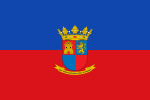Torrox
This article may incorporate text from a large language model. (December 2023) |
This article needs additional citations for verification. (December 2023) |
- For the soil type, see oxisol.
Torrox | |
|---|---|
 Plaza de la Constitucion | |
| Coordinates: 36°45′N 3°57′W / 36.750°N 3.950°W | |
| Sovereign state | |
| Autonomous community | |
| Province | |
| Comarca | La Axarquía |
| Government | |
| • Mayor | Antonia Claros Atencia |
| Area | |
| • Total | 51 km2 (20 sq mi) |
| Elevation | 120 m (390 ft) |
| Population (2018)[1] | |
| • Total | 16,465 |
| • Density | 320/km2 (840/sq mi) |
| Demonym | Torroxeños |
| Time zone | UTC+1 (CET) |
| • Summer (DST) | UTC+2 (CEST) |
| Website | Official website |
Torrox is a municipality in the province of Málaga in the autonomous community of Andalusia, southern Spain. It belongs to the comarca of Axarquía. It is located in the Costa del Sol (specifically the Costa del Sol Oriental), on the shores of the Mediterranean Sea and the foothills of the Sierra de Almijara.
It is frequented especially by German and British tourists. The city itself is divided into sections: Torrox Costa on the sea and Torrox Pueblo, 4 km inland. Torrox Park, a housing section in between the costa and the village, could be seen as another division. Torrox is near Nerja.
With an average annual temperature of 18 degrees, it claims to have "the best weather in Europe."[2]
History[edit]
Torrox is a historic town with a rich cultural heritage dating back to ancient civilizations. Nestled along the Mediterranean coastline, Torrox has witnessed the influences of Phoenicians, Romans, and Arabs, each leaving their mark on the town's history and development.
Ancient Settlements and Archaeological Discoveries[edit]
Before the Roman era, the Phoenicians had established settlements in the region, much like in other parts of the Málaga coast. Torrox Costa, despite its modern appearance, has a history dating back to ancient times. Phoenician remains found along the coast suggest the likelihood of Phoenician settlements in Torrox.
These may have laid the foundation for the ancient Roman town of Claviclum, which eluded archaeologists for years, was eventually discovered in the vicinity of Torrox and believed to have been situated on the site of today's Torrox Costa. Lighthouse keeper Tomás García Ruiz played a pivotal role in this discovery, unearthing a thermal baths, villa, garum factory, and a necropolis dating from the 3rd and 4th centuries BC. The site's excavation revealed an established settlement.
Arrival of Abd al-Rahman I ibn Mu’awiy[edit]
In 755, Prince Abd al-Rahman I ibn Mu’awiy, the last representative of the Umayyad dynasty, arrived in Torrox after fleeing Damascus. Here, he gathered an army and went on to become the first independent Emir and Caliph of Córdoba. This period saw the promotion of culture, commerce, agriculture, and the arts in the region.
Conquest and Award of Title[edit]
Torrox was eventually conquered by the Catholic Monarchs in 1487, following the capture of Vêlez-Málaga. In 1503, it was awarded the title of Most Noble and Loyal Town of Torrox in a Royal Decree signed by Queen Isabella I. This decree also authorized the construction of a coastal tower to defend against pirate attacks.
Economic Development and Challenges[edit]
In the mid-19th century, Torrox boasted three flour factories, two oil factories, two pottery workshops, and factories producing liquor and sugar cane, including those owned by the Larios family. However, a series of earthquakes in 1884 and 1885 caused significant destruction, leading to an economic crisis. Many residents emigrated to Argentina, primarily Buenos Aires, during the early 20th century.
Cultural and Architectural Heritage[edit]
Torrox retains its historical charm with remnants of its Andalusian past. The upper district of Almedina is a surviving example of this heritage. The town's urban design is characterized by contrasts, minimal space usage, and striking combinations of light and shade. Prominent landmarks include Calle Espadas and Calle La Bola, along with the 17th-century Iglesia de Nuestra Señora de la Encarnación, which incorporates a turret from the former fortress.
Economy[edit]
Torrox's economy is driven by two major forces. Tourism plays a significant role, especially in coastal areas like Torrox-Costa, El Morche, and Peñoncillo. Traditional agriculture remains vital, with greenhouses near the town producing vegetables, fruit, tropical produce, and almond trees.
Unique Natural and Cultural Features[edit]
Torrox's local countryside is home to a unique species, the monarch butterfly, which is now extinct in the rest of Europe. The town also boasts nine kilometers of relatively unexplored beaches, a natural resource that supports tourism. Additionally, rural tourism, mainly of German origin, thrives in Torrox, and local craft workshops offer activities such as silk and cloth painting, glass pottery, and woodwork.
Notable people[edit]
- Almanzor, Former Chancellor of the Umayyad Caliphate of Córdoba
- Raúl Baena, footballer
Twin towns[edit]
References[edit]
- ^ Municipal Register of Spain 2018. National Statistics Institute.
- ^ Sol, Costa del. "The best climate in Europe is in Malaga: Torrox". blog.visitacostadelsol.com. Retrieved 2023-09-28.





